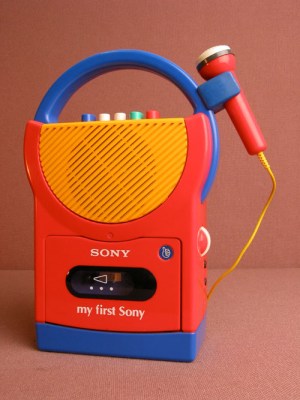In light of the recent layoffs by Sony to the tune of 10,000 employees, I think it’s important to see where Sony currently resides in the tech ecosystem and why the company, once the darling of the CE and PC set, went so far off track.
As background, I recommend you read Joel Johnson’s excellent series on Sony. He wrote it two years ago on Gizmodo and it is one of the most thorough and enjoyable examinations of what was then a sputtering juggernaut. One of the funniest pieces is this man-on-the-street video that asks people what they think of Sony. The kindest praise? One lad called the company “Decent” and another said he owned a Sony TV. The last guy in the video takes a moment to compose his thoughts and says “Sony: fast, cheap, and Japanese.”
Sony rose as a direct reaction to the post-WWII industrialization of Japan. The company, founded by two wartime buddies, Masaru Ibuka and Akio Morita, aimed to bring cheap electronics (really electrically powered appliances) to a country that had a surplus of electricity. The founders were geeks of the first order, dedicated to tinkering and experimentation. In an original prospectus, Ibuka wrote:
For a while, Sony was the Apple of the tech crowd. Vaio computers and Sony CE devices graced the homes of everyone from 80s equities traders to dot-commers partying like it was 1999. I remember a time when my co-workers in Europe would hit duty free shops just to pick up one of Sony’s tiny laptop computers, the chiclet keys so small that the fat-fingered had to hunt and peck like beginning typists. People bought a PS2 just to get a DVD player in the home at a time when DVD players were falling from peak prices. Sony brought the cool.
Now Sony is bringing the red in. The company just announced a $6.4 billion loss for FY 2012 and the brand is bleeding cachet. If you asked people what Sony stood for now you’d probably hear something about the PS3 and maybe something about TVs. If we are to use the analogy of the three legged stool – one leg being value, the second being “cool,” and the third being market share – Sony doesn’t have a single leg to stand on.
Vizio took Sony out in terms of value. Vizio makes TVs – cheap TVs – and there’s little value in buying upmarket when the TV-makers themselves are trying to punch out new features as fast as they can think them up. Smart TV? Better upgrade. 3D? Get ye to the Best Buy. New 4K resolution? Where do we line up? TV makers are taking a page out of the cellphone playbook and hoping for an upgrade cycle of 18 months rather than six years. As a result, the need to purchase an expensive new Sony is valueless.
Second, Apple took Sony’s cool. Sony used to be synonymous with content creation. No longer. Even the Sony tools like Vegas are runners up at best and are often still trounced by Final Cut and Premiere. Sony only maintains its cool thanks to excellent gaming hardware like the Vita but you’d be hard-pressed to find anyone still insisting on Sony hardware to get any real work done. What, indeed, is the difference between a Dell and a Sony and HP PC anymore?
Finally, Samsung took Sony’s market share. Samsung (and HTC, in the smartphone space) have replaced the ubiquitous Sony logo almost everywhere it matters. Samsung even owns the “white goods” space, selling thousands of air conditioners and washer/dryers alongside its TVs, phones, and media players. All this could change, obviously, but Samsung has thus far bested Apple in phone market share and could do so further in any number of markets.
Sony’s founders named their company Sony because it sounded like “sonus” and “sonny,” the former being related to audio and the latter being what the Japanese thought folks were calling each other over in America – “sonny boy.” They went through a number of branding iterations – “Make.Believe” being the latest – and now they’re attempting the One Sony initiative. They’re beginning the initiative by firing 10,000 people in order to streamline operations and, obviously, create one, unified Sony.
Perhaps instead of streamlining and branching out into medical imaging and emerging markets, One Sony should stand for “everyone should own one Sony item.” Given the past efforts, it wouldn’t hurt.
